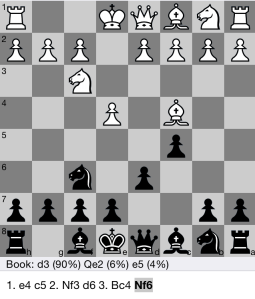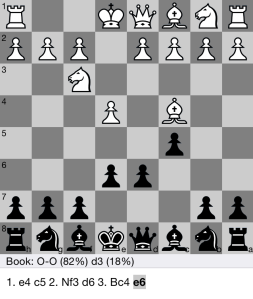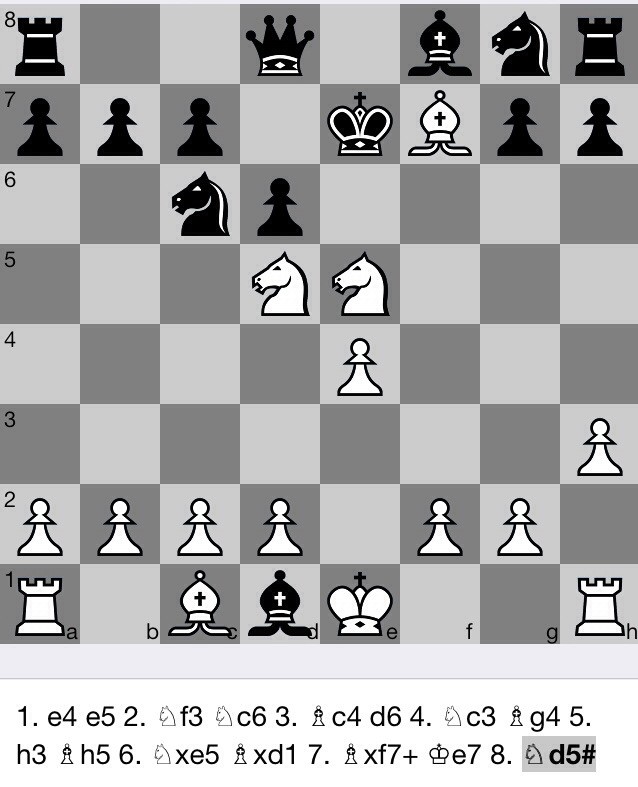Here’s a great way to explore openings and see the name of each one:
http://www.365chess.com/opening.php?m=4&n=37&ms=e4.c5.c3&ns=3.3.37
Here’s a great way to explore openings and see the name of each one:
http://www.365chess.com/opening.php?m=4&n=37&ms=e4.c5.c3&ns=3.3.37

In the Sicilian Defence (1. e4 c5), which we looked at in a previous post, after 2. Nf3 d6 the main line is 3. d4 cxd4 but you can often find that players unfamiliar with the Sicilian will play Bc4 as they don’t know to respond with d4 and the bishop line is open so in something of a panic will move the bishop to Bc4 as shown above.
 If you’re expecting d4 from white then this can also be a bit of a surprise for black so better to be prepared for it. Nf6 is really the best move attacking the e4 pawn though Nc6 is also possible as you can see from the top image (courtesy of Stockfish) both of which are good development moves so you stick to your game plan. Nf6 prepares for castling on the black kingside and forces white to defend the e4 pawn with d3 which is the best move for white and you see how black is now calling the shots temporarily which will unsettle your opponent if they’re not used to this position.
If you’re expecting d4 from white then this can also be a bit of a surprise for black so better to be prepared for it. Nf6 is really the best move attacking the e4 pawn though Nc6 is also possible as you can see from the top image (courtesy of Stockfish) both of which are good development moves so you stick to your game plan. Nf6 prepares for castling on the black kingside and forces white to defend the e4 pawn with d3 which is the best move for white and you see how black is now calling the shots temporarily which will unsettle your opponent if they’re not used to this position.
 You might start thinking defensively as white is now attacking the f7 pawn and play e6 but that isn’t the best move and puts no pressure on white meaning they can castle without much thought which is what the beginner player would be looking to do and then by the time you play Nf6 as black white is already safe and black is under pressure to castle so much better to play Nf6 and attack the weaknesses in the white position. Chess can sometimes be a game of distraction so don’t get distracted!
You might start thinking defensively as white is now attacking the f7 pawn and play e6 but that isn’t the best move and puts no pressure on white meaning they can castle without much thought which is what the beginner player would be looking to do and then by the time you play Nf6 as black white is already safe and black is under pressure to castle so much better to play Nf6 and attack the weaknesses in the white position. Chess can sometimes be a game of distraction so don’t get distracted!
 After 1. e4 c5 2. Nf3 d6 3. Bc4 Nf3 4. d3 and Nc6 white has to be careful as he will be tempted to develop his bishop or knight when actually analysis shows 5. c3 should be played to prepare d4 and that’s often a move that white doesn’t want to play as it feels like you’re not developing pieces and attacking which everyone instinctively wants to do. Castling would also be an option for white which many players would do and in that case black should consider g6 which looks like the Sicilian dragon but e6 is equally good preparing d5.
After 1. e4 c5 2. Nf3 d6 3. Bc4 Nf3 4. d3 and Nc6 white has to be careful as he will be tempted to develop his bishop or knight when actually analysis shows 5. c3 should be played to prepare d4 and that’s often a move that white doesn’t want to play as it feels like you’re not developing pieces and attacking which everyone instinctively wants to do. Castling would also be an option for white which many players would do and in that case black should consider g6 which looks like the Sicilian dragon but e6 is equally good preparing d5.
Actually if you’re going to move the bishop then Bb5+ would be a better move and is a popular move in the Sicilian opening which we can look at in another post.
Here’s a video on the Greco attack showing the main line and some key variations.
http://www.youtube.com/watch?v=hanZ0QnZgfc
I’ve been reading a great book for juniors on openings called Ten ways to succeed in the opening by http://onionschess.co.uk and it gives me an opportunity to talk about a trap that isn’t a trap in the two knights defence.
After 1. e4 e5 2. Nf3 Nc6 3. Bc4 (Italian) black plays Nf6 which is the two knights defence and commonly seen at junior level white has a choice. Nc3 is common at junior level to defend the e4 pawn but black can then play Nxe4 setting the trap. I still haven’t found a decent app to show the most common traps if anyone knows of one?
If white responds with Nxe4, which is of course the reason white played Nc3 then black has a fork up his sleeve with pawn to d5 forking the bishop and knight. This is meant to be a reason not to play these moves but of course with any trap there is sometimes a way out if you look hard enough.
Black can now justice his bishop to d3 defending the knight which is the main line and after xe4 we have Bxe4 and material is equal. The trap was not a trap after all but still worth knowing as your opponent may be surprised and not know how to respond.
You then see Bd6 defending the pawn and either d4 attacking or castles from white and the game continues.
Of course Nc3 is still not a great move for this reason and better would be d4 attacking the centre, c3 preparing an even stronger d4 and of course the famous Ng5 which is the Fried Liver.
?
The Traxler is a variation of the Italian-Two Knights Game. It’s not quite the Fried Liver attack but shares the move Ng5 which also characterises the Fried Liver. It’s one of the first variations beginners learn and is popular as an attacking move at a junior level.
Technically the Fried Liver is 1. e4 e5 2. Nf3 Nc6 3. Bc4 Nf6 (Two Knights) 4. Ng5 d5 5 . exd5 Nxd5 6. Nxf7. You’ll notice that d5 is the response to Ng5 to block the most dangerous elements of the Fried Liver attack.
In the Traxler the first three moves from both sides are the same with white playing Ng5 on move four. But instead of replying with d5 black responds with Bc5. d5 is by far the most common move at professional level but Bc5 is the other possible response and is a counter attack that leads to a fun game. It’s also known as the Wilkes-Barre Variation.
Bxf7+ is then the most common move which wins a pawn but Nxf7 forks the queen and the rook so wins more material but watch out for the counterattack! After Nxf7 black can respond with his own threat of Bxf2+ which is the natural move and white has a choice now of Kxf2 winning a bishop or Kf1. If Kxf2 then Nxe4 with another check and the King should retreat to g1 or he is in trouble.
If the king goes to e2 then Nd4+ and black is winning.
Below is a game I played as black and losing to the Ng5 move.
1. e4 e5 2. Nf3 Nc6 3. Bc4 Nf6 4. Ng5 Bc5 5. Nxf7 Bxf2+ 6. Kf1 O-O 7. Nxd8+ Kh8 8. Nf7+ Rxf7 9. Bxf7 Ng4 10. Qxg4 d6 11. Qf3 Bd4 12. Be8 d5 13. Qf8#
 The legal trap is a chess trap in the Italian opening. Traps are fun to look at because they lead to a checkmate in a way you may not have expected. You can see the moves in the picture that lead up to this check mate and there’s a great video on this from the chess website.
The legal trap is a chess trap in the Italian opening. Traps are fun to look at because they lead to a checkmate in a way you may not have expected. You can see the moves in the picture that lead up to this check mate and there’s a great video on this from the chess website.
If you want to see the moves played I’ve also included a gif file below which animates the moves.
Essentially white opens with the Italian and if black plays the Philidor defence and then moves the black bishop to g4 pinning the knight then the trap is unleased.
Well it’s time now to look at things from the perspective of black and the well known Sicilian Defence which is the most popular response from black. Instead of responding by copying black opens up his own space on the queenside.
This is the reason why d4 is now actually preferred for white because of how strong this response is from black. White usually continues with Nf3 to try and attack and control the centre and prepare d4 which will then be defended by the knight. Notice that black now has two centre pawns versus one for white which is what makes the Sicilian so strong. But white gains a lead in development to offset this.
White then responds with d6 defending the c5 pawn and stopping white from pushing to c5. But the bishop on f8 is now blocked in for black so will need a further move to develop this in the future such as e6.
The main line is d4 from white which black captures and white recaptures with the knight which is known as the open version of the sicilian. Black moves Nf6 attacking the e4 pawn and white responds with Nc3 defending.
Pawn to a6 is the main line and known as the Najdorf variation. Nc6 continues the Open version of the Sicilian and g6 is known as the dragon and we’ll look at some of those variations next.
Here’s a great video from the chess website going through the Sicilian Defence.
The steps method is a great way to teach chess and the books are available below or shredder has the first three steps as software.
http://www.stappenmethode.nl/en/index.php
The method quite rightly points out that tactics and strategy are more important to teach before positional play at an early age and the steps method is a great way to do that.

A few days ago (25th February 2014 to be precise) Magnus Carlsen launched his new chess app called Play Magnus with a corresponding website at http://playmagnus.com/. This goes along with his new YouTube channel at http://www.youtube.com/magnuscarlsen where his first free training video has just been released.
The app is pretty clever and allows you to play against a Magnus computer with different age ratings. The whole idea is that you register, play and potentially win a chess to play against Magnus in a secret location next year. There are some free videos but you have to upgrade in the app to be allowed to enter the competition and you have to purchase some videos. Shame you have to upgrade to no ads to enter the competition but apart from that it’s very well done.
So what do you think and what age can you beat Magnus at?

We left off in the last move with exd4 followed by cxd4 leaving the bishop in an attacked position.
You can see the almost exclusively here the black bishop moves to b4 to check the white king and white has a decision to make.
Bd2 seems to be the most popular move and gives white a small advantage in the engines. I think because the black bishop now has nowhere to go so has to exchange bishops and white can then develop the b1 knight.
But Nc3 is known as the Greco attack and has a great trap which is well worth looking at so we will. What do you play in this position?
If you moved the b knight to d2 then d5 would be coming and black looks better.
Of course in this position black is going to take the e4 pawn with the knight for free so it’s pretty much the only move for black.
To unpin the white king white is going to castle. Now black has two attackers on the c3 knight so the main line is Bxc3 which leads us to the end of the main line for the Greco attack.
From here the most popular move is d5 which takes us into the Moeller attack so that’s for another post! Bxc3 from white invites black to take back with the knight by Nxc3 but that would be a mistake. As you can see in the checkmate post white would move the queen to b3 attacking the knight and once the knight moves the bishop is set loose with Bxf7+!
At this point the black king has to move to f8 and has lost the chance to castle and is about to lose their queen so white is clearly winning which is why black should have played d5 earlier to block the bishop when it wasn’t defended by the queen. Even after taking the c3 pawn white should still play d5 as if the white bishop takes the d5 pawn the c3 black knight can take back.